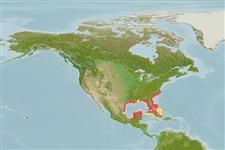Environment: milieu / climate zone / depth range / distribution range
Ecology
Marine; reef-associated; depth range 0 - 30 m (Ref. 26938). Subtropical; 36°N - 18°N, 99°W - 75°W (Ref. 55283)
Western Atlantic: North Carolina, USA to the northern Gulf of Mexico and Yucatan, Mexico.
Size / Weight / Age
Maturity: Lm ? range ? - ? cm
Max length : 75.0 cm TL male/unsexed; (Ref. 9710); 76.0 cm TL (female); common length : 60.0 cm TL male/unsexed; (Ref. 6077)
Short description
Morphology | Morphometrics
Elongate, with a heart-shaped disk terminating in a wedge-shaped snout with a few enlarged tubercles on tip (Ref. 26938). Ashy gray to olive brown or chocolate brown. Entire upper surface is thickly freckled with several hundred small whitish dots. Lower surface is pale yellow or yellowish white or plain white, fins slightly darker than trunk (Ref. 6902).
Inhabits sandy and weedy bottoms, sometimes near patch reefs. Also found along beaches from shoreline to depths of 30 m (Ref. 26938). Usually buried in the sand or mud. Feeds on mollusks and crustaceans. Ovoviviparous, with up to 6 in a litter (Ref. 12951). Size at birth 20 cm (Ref. 12951). Generally uncommon (Ref. 9710).
Life cycle and mating behavior
Maturity | Reproduction | Spawning | Eggs | Fecundity | Larvae
Exhibit ovoviparity (aplacental viviparity), with embryos feeding initially on yolk, then receiving additional nourishment from the mother by indirect absorption of uterine fluid enriched with mucus, fat or protein through specialised structures (Ref. 50449).
Robins, C.R. and G.C. Ray, 1986. A field guide to Atlantic coast fishes of North America. Houghton Mifflin Company, Boston, U.S.A. 354 p. (Ref. 7251)
IUCN Red List Status (Ref. 130435)
Threat to humans
Harmless
Human uses
Fisheries: subsistence fisheries
More information
Age/SizeGrowthLength-weightLength-lengthLength-frequenciesMorphometricsMorphologyLarvaeLarval dynamicsRecruitmentAbundanceBRUVS
ReferencesAquacultureAquaculture profileStrainsGeneticsElectrophoresesHeritabilityDiseasesProcessingNutrientsMass conversion
Tools
Special reports
Download XML
Internet sources
Estimates based on models
Preferred temperature (Ref.
123201): 23.4 - 27.8, mean 26.3 °C (based on 280 cells).
Phylogenetic diversity index (Ref.
82804): PD
50 = 0.5039 [Uniqueness, from 0.5 = low to 2.0 = high].
Bayesian length-weight: a=0.00282 (0.00135 - 0.00588), b=3.12 (2.95 - 3.29), in cm total length, based on LWR estimates for this Genus-body shape (Ref.
93245).
Trophic level (Ref.
69278): 3.6 ±0.50 se; based on food items.
Resilience (Ref.
120179): Very Low, minimum population doubling time more than 14 years (Fec assumed to be <10).
Fishing Vulnerability (Ref.
59153): Moderate to high vulnerability (50 of 100).
Nutrients (Ref.
124155): Calcium = 12.2 [1.5, 49.3] mg/100g; Iron = 0.424 [0.102, 1.177] mg/100g; Protein = 20.1 [17.9, 22.2] %; Omega3 = 0.128 [0.053, 0.310] g/100g; Selenium = 11.3 [3.2, 35.3] μg/100g; VitaminA = 33 [11, 104] μg/100g; Zinc = 0.63 [0.30, 1.34] mg/100g (wet weight);
